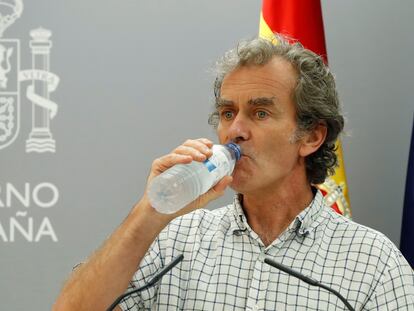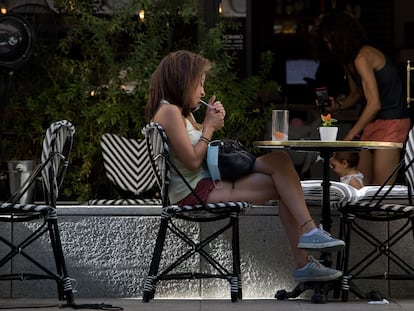Catalonia will quarantine an entire class for 14 days if a coronavirus case is detected
The region's protocol for the upcoming academic year also includes closure for a school if there are two infections in different groups, pending approval by the health authority


During the upcoming school year in Catalonia, if a coronavirus case is detected in a student or teacher, the whole class will go into quarantine for two weeks, even if the other classmates test negative. If the case is simply suspected, only the person in question will go into quarantine until the results of a PCR test come back. And a school will close down entirely if there are two positive cases in two different groups, if the regional health authority orders it. These are some of the measures that are being designed by the education and health departments to set out the steps that will be followed when possible coronavirus cases are detected in a school in the northeastern Spanish region.
“This will be a school year with extraordinary characteristics,” said Catalan education chief Josep Bargalló. “There will be incidents from day to day and it will be necessary to know how to respond.” He cited the “positive” experience of the summer camps that have taken place in recent weeks as an example of what could happen from September 14 onward, when the term gets going. “We have had 250,000 minors in camps, and while there have been some incidents, they have been few and they have been resolved.”
This protocol has been created to keep schools open, not to close themMarc Ramentol, general director of Profesionales de la Salud
Both healthcare and education are powers that are devolved to Spain’s regions, meaning that, like Catalonia, each area of the country will be coming up with its own protocols ahead of the return to school of students in September.
The protocol being drawn up in Catalonia specifies that when a symptom that corresponds to coronavirus is detected, the student will be isolated and the family will be informed. Schools will also have a dedicated nurse from a primary healthcare center, the same professional that is currently assigned for vaccinations or for health education programs. The school principal will be able to contact this nurse if there are any doubts about a symptom. Principals will also receive a training course before the school year begins.
It will be a pediatrician or primary healthcare doctor who will decide whether or not a PCR test is needed, and if so this will be carried out within 24 hours. The regional government has also committed to getting the results back in the same time frame. In the meantime, the student or teacher in question will be isolated at home, together with the other members of the household. The rest of the group will go about their daily lives as usual.
If the result is positive, the entire class will go into quarantine for two weeks, and all of them will be given a PCR test. They will have to stay in quarantine whatever the result, apart from anyone who has had the illness over the previous six months. Parents will only be put in quarantine should their child test positive.
“PCRs come back positive from a certain day of incubation – they can come back negative but that doesn’t mean that you are not infected,” explains Marc Ramentol, the general director of Profesionales de la Salud, a regional body responsible for the training of health professionals, among other responsibilities. “The idea is to halt those cases that are incubating.” The education department will leave decisions on how to continue with classes in the hands of school principals. “The schools should have planned for this,” said Bargalló.
Teachers who deal with various different groups or classes will have to wear masks and maintain social distancing
The complete closure of a school – also for 14 days – will only be implemented if two positive cases are detected in two different groups in the same school, and this will have to be authorized by the health authorities after evaluating the situation. “This protocol has been created to keep schools open, not to close them,” explained Ramentol.
In the case of teachers who deal with various different groups or classes, they will have to wear masks and maintain social distancing. If they were to test positive, students will not be isolated because they are not considered to be close contacts.
Relatives who live in the same home with a suspected case will also have to isolate until the PCR test results are returned. If they come back negative, the parents will be able to return to work and the siblings can go back to school. But if it is positive, all cohabitants will be tested, but independently of the result they will have to go into quarantine for 14 days.
The protocol also specifies that parents will not be able to take their children to school if they show symptoms such as a high temperature, a cough, a sore throat, a headache, muscular pain, vomiting or diarrhea. Nor will they be able to if the student is living with someone who has been infected. They will be able to return to school once the symptoms have passed or 24 hours after their fever breaks, and in the case of those with infections, three days after the symptoms have disappeared.
As for other measures, face masks will not be necessary in the case of stable groups – i.e. in the classroom. But they will have to be used when entering and leaving the school, in the corridors and in areas that are shared with other groups and where students can mix, such as the canteen, laboratories and the schoolyard.
Both the education and health departments have admitted that the rules may be changed if the situation gets worse, and they are not ruling out establishing the use of masks in classrooms with children aged 10 and over.
English version by Simon Hunter.
Tu suscripción se está usando en otro dispositivo
¿Quieres añadir otro usuario a tu suscripción?
Si continúas leyendo en este dispositivo, no se podrá leer en el otro.
FlechaTu suscripción se está usando en otro dispositivo y solo puedes acceder a EL PAÍS desde un dispositivo a la vez.
Si quieres compartir tu cuenta, cambia tu suscripción a la modalidad Premium, así podrás añadir otro usuario. Cada uno accederá con su propia cuenta de email, lo que os permitirá personalizar vuestra experiencia en EL PAÍS.
¿Tienes una suscripción de empresa? Accede aquí para contratar más cuentas.
En el caso de no saber quién está usando tu cuenta, te recomendamos cambiar tu contraseña aquí.
Si decides continuar compartiendo tu cuenta, este mensaje se mostrará en tu dispositivo y en el de la otra persona que está usando tu cuenta de forma indefinida, afectando a tu experiencia de lectura. Puedes consultar aquí los términos y condiciones de la suscripción digital.
More information
Últimas noticias
Welcome to the post-religion era: The idea of Christianity as the absolute truth has become obsolete
‘I thought you would like it’: The risky sexual practice popularized by TV shows and TikTok
The digitalization of tourism: ‘They promise experiences and gave us the worst possible one’
Mexican peso defies uncertainty with forecasts of a new period of stability in 2026
Most viewed
- Sinaloa Cartel war is taking its toll on Los Chapitos
- Reinhard Genzel, Nobel laureate in physics: ‘One-minute videos will never give you the truth’
- Oona Chaplin: ‘I told James Cameron that I was living in a treehouse and starting a permaculture project with a friend’
- Why the price of coffee has skyrocketed: from Brazilian plantations to specialty coffee houses
- Silver prices are going crazy: This is what’s fueling the rally










































